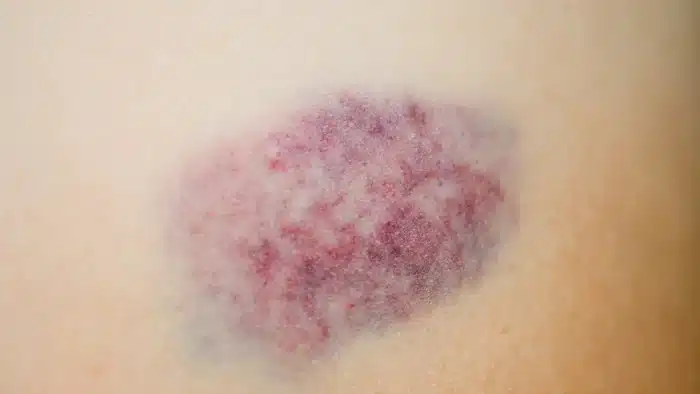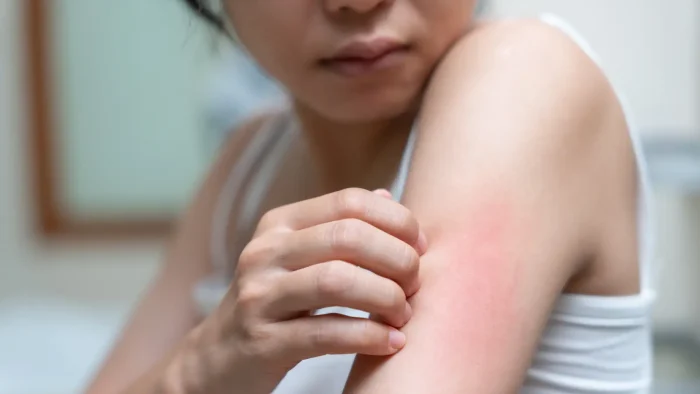
Side effects are a common consideration when using cosmetic injectables. A 2023 study on dermal fillers found that adverse reactions could include swelling, redness, and bruising at the injection site, though more severe complications are rare. It’s essential to understand the risks before undergoing any treatment.
Revanesse is a popular hyaluronic acid filler used for facial enhancement. Although it provides smooth, natural-looking results, users may still experience some side effects, as with other injectables. Knowing what to expect can help ensure a safe and effective treatment process.
In this article, we will explore a list of Revanesse side effects, including how to identify and manage them so that you can make an informed decision.
Key Takeaways
- Temporary swelling and redness at the injection site. Mild bruising, which may appear as blue or purple marks. Tenderness that typically resolves within two weeks.
- Itching or rash can occur but usually subside in a few weeks. Nodules or lumps may form due to the body’s reaction to hyaluronic acid. Discoloration or hyperpigmentation can affect skin appearance post-treatment.
- Severe allergic reactions, though rare, can include difficulty breathing and facial swelling. Infections may lead to redness, warmth, pus, or fever. Vascular occlusion can block blood vessels, impacting surrounding skin and tissues.
- Keep the injection site clean, using mild soap and water without scrubbing. Over-the-counter pain relievers may help alleviate discomfort. Follow the doctor’s aftercare instructions for optimal results.
About: Doctor Medica is your trusted supplier of top-quality dermal fillers, viscosupplements, and more for your medical practice. We offer genuine products from leading brands at the lowest prices in the market. If you’re looking to buy Revanesse online for your practice, contact the Doctor Medica today.
Common Side Effects

After receiving Revanesse dermal fillers, some mild side effects are common, but they’re usually short-lived and manageable.
- Temporary Swelling and Redness: These reactions are simply your body’s natural reaction to the Revanesse filler treatment and should subside within a few days.
- Mild Bruising: You might notice some slight bruising, which appears as small blue or purple marks where the needle was inserted. This happens when tiny blood vessels under the skin are affected during the injection process, but the bruising typically fades on its own.
- Tenderness at the Injection Site: Some people feel a bit of tenderness or sensitivity in the area where they received the injection. This discomfort is generally mild and goes away within a week or two, making it just a temporary part of the recovery process.
Rare Side Effects

Although less common, there are a few rare side effects to be aware of when using Revanesse dermal fillers.
- Itching or Rash: Itching or rash can happen after getting Revanesse injections. While this is uncommon, it can happen shortly after the injections. These symptoms usually clear up on their own within a few weeks.
- Nodules or Lumps: These can feel firm to the touch under the skin and occur when the body reacts to the hyaluronic acid in the filler. While not typical, it’s something to watch out for and discuss with your provider if it happens.
- Discoloration or Hyperpigmentation: Another rare side effect is skin discoloration or hyperpigmentation, where certain areas of the skin may become darker following treatment. This is usually temporary but should be monitored if it occurs.
Serious Side Effects

- Severe Allergic Reactions: Symptoms can include difficulty breathing, hives, or swelling of the face, lips, or throat. If any of these occur, immediate medical attention is necessary.
- Infection: An infection can develop if bacteria enter the injection site. Signs of an infection include redness, swelling, warmth, or the presence of pus at the injection area. You might also feel unwell with a fever. If any of these symptoms occur, it’s important to seek treatment as soon as possible to prevent complications.
- Vascular Occlusion: One of the most serious risks of filler treatments is vascular occlusion, which happens when the filler blocks a blood vessel. This can reduce blood flow to the surrounding tissues, causing pain and possibly damaging the skin. If you notice extreme pain or discoloration after your injection, contact your healthcare provider immediately.
Managing Side Effects
After getting Revanesse injections, it’s important to take immediate steps to minimize any side effects. Gently cleaning the injection site with mild soap and water can help keep the area free from bacteria—just avoid any harsh scrubbing. If you experience mild discomfort, over-the-counter pain relievers should ease it. Follow your doctor’s specific aftercare instructions to help reduce side effects and ensure smooth healing.
For long-term care, most side effects like swelling, redness, and bruising typically resolve within two weeks. However, it’s a good idea to monitor your skin even after the initial recovery period. Regular check-ins can help catch any potential issues early. Patients often compare their recovery experiences when deciding between treatments like Revanesse vs Juvederm, as each may have slightly different healing times or side effects.
You should seek medical advice if swelling, redness, or bruising persists beyond two weeks. If you notice any signs of infection, such as fever or the treated area becoming unusually red and hot, contact your healthcare provider right away to ensure proper care.
Conclusion
It’s important to be aware of the possible side effects of Revanesse before undergoing treatment. While most people only experience mild reactions like swelling or tenderness that go away fairly quickly, there can be rare complications, such as lumps or allergic reactions.
Taking good care of your skin after the procedure and monitoring how you feel can help ensure a smooth recovery. If something doesn’t feel right, it’s always best to check in with your doctor. This will help you stay both safe and confident in achieving the results you’re looking for.
FAQs
1. What are Revanesse side effects?
Revanesse is a type of dermal filler, and like any other medical treatment, it can have side effects. These may include swelling, redness, pain, or bruising at the injection site.
2. Are all the side effects of Revanesse serious?
Not necessarily! Many common side effects, such as mild swelling or redness, tend to fade away after a few days but remember that every person’s body responds differently.
3. Where can I find a complete list of Revanesse side effects?
For an exhaustive list of potential side effects from using Revanesse, it’s best to consult with your healthcare provider or check official resources provided by health organizations.
4. What should I do if I experience severe side effects from Revanesse?
If you notice severe reactions after receiving Revanesse injections, don’t panic—act promptly! Contact your healthcare provider immediately for guidance on what steps to take next.
References
Colon, J., Mirkin, S., Hardigan, P., Elias, M. J., & Jacobs, R. J. (2023). Adverse Events Reported From Hyaluronic Acid Dermal Filler Injections to the Facial Region: A Systematic Review and Meta-Analysis. Cureus, 15(4), e38286. https://doi.org/10.7759/cureus.38286
Kyriazidis I, Spyropoulou GA, Zambacos G, et al. Adverse Events Associated with Hyaluronic Acid Filler Injection for Non-surgical Facial Aesthetics: A Systematic Review of High Level of Evidence Studies. Aesthetic Plastic Surgery. 2023;48(4):719-741. doi:10.1007/s00266-023-03465-1
PMA P160042: FDA Summary of Safety and Effectiveness Data SUMMARY of SAFETY and EFFECTIVENESS DATA (SSED). https://www.accessdata.fda.gov/cdrh_docs/pdf16/P160042B.pdf
Related Articles
Joanna Carr
Plasmolifting Before and After – Visible Results in Skin Rejuvenation
Discover the visible results of Plasmolifting in skin rejuvenation. Learn how this innovative treatment uses platelet-rich plasma (PRP) to improve ski...
Joanna Carr
Lemon Bottle Fat Dissolving Reviews – Patient and Practitioner Insights
Discover real patient reviews and expert opinions on Lemon Bottle fat dissolving injections. Learn about treatment comfort, side effects, and how it c...
Joanna Carr
Teosyal Filler for Lips – Pump and Volume
Teosyal fillers are a popular choice for lip augmentation, providing natural-looking results and enhanced lip volume.


